Introduction
Generative AI in ecommerce is reshaping how retailers operate in today’s fast-moving digital landscape. Customers expect relevant experiences, accurate product details, and smooth journeys from search to checkout. At the same time, retailers must manage vast product catalogs, unpredictable demand, and intense competition. Manual processes alone cannot keep up.
Generative AI fills this gap by creating product content, personalizing recommendations, predicting demand, and optimizing pricing. Instead of being limited to automation, it adds intelligence, context, and adaptability to every stage of the shopping journey.
Key benefits for businesses include:
- Scalability: Faster product onboarding and catalog management.
- Accuracy: Consistent descriptions and smarter demand forecasts.
- Personalization: Relevant offers that build loyalty.
- Efficiency: Reduced waste in inventory and pricing strategies.
In short, generative AI is not a future vision but a practical tool transforming e-commerce today. To learn more about related applications, explore our guide on AI-Powered Supply Chain Optimization for Retail & E-commerce
Generative AI in E-commerce: An Overview
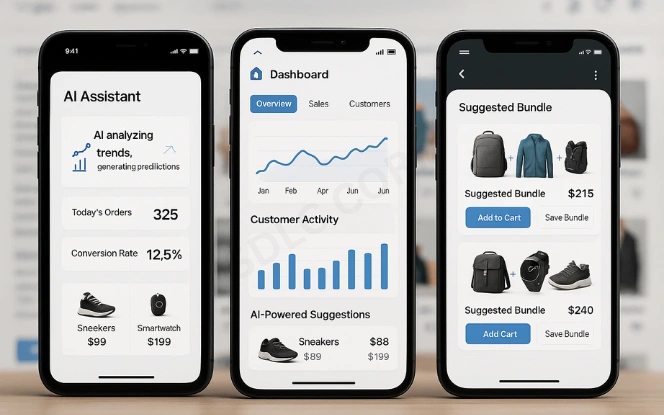
Generative AI creates new data based on patterns in existing information. For e-commerce, this ability has direct applications:
- Text generation: Automated product descriptions, FAQs, and marketing copy.
- Forecasting: Demand planning that adapts to seasonal and external trends.
- Recommendations: Personalized bundles for each shopper.
- Pricing: Simulating multiple scenarios for revenue optimization.
Unlike traditional AI, which predicts or classifies, generative AI produces fresh content and insights. For example, instead of simply recommending “similar products,” it can generate unique product bundles that match customer intent.
Why it matters for retailers:
- It reduces manual effort in catalog management.
- It speeds up time-to-market for new products.
- It provides actionable intelligence that supports both operations and marketing.
When implemented with oversight, generative AI becomes a foundation for stronger efficiency and better customer experiences. Businesses should see it as an enabler, combining automation with intelligence to stay competitive.
Product Content and Automation
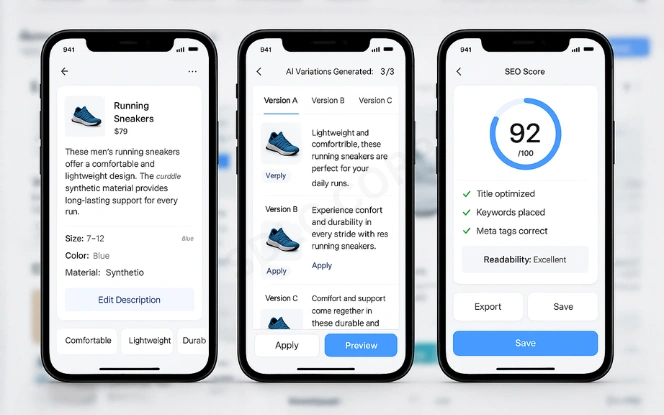
Managing thousands of product listings requires accuracy, speed, and consistency. Manual processes often fall short, leading to gaps in descriptions or missed SEO opportunities.
How generative AI helps:
- Automating product descriptions with AI creates consistent, detailed listings at scale.
- It pulls structured data like size, color, and features into engaging text.
- It generates multiple variations for use across websites, marketplaces, and ads.
Advantages:
- Faster onboarding of new products.
- Fewer human errors in content.
- Higher visibility in search results.
Hybrid approach:
- AI generates the base descriptions.
- Human editors refine tone, check compliance, and ensure cultural relevance.
This mix ensures both scale and authenticity. Businesses adopting automated content workflows reduce costs, improve efficiency, and free staff to focus on creative strategy instead of repetitive tasks. For further insights, see How to Use AI in WordPress for Automation and Content Creation enhances digital catalog management.
Personalization and Recommendations
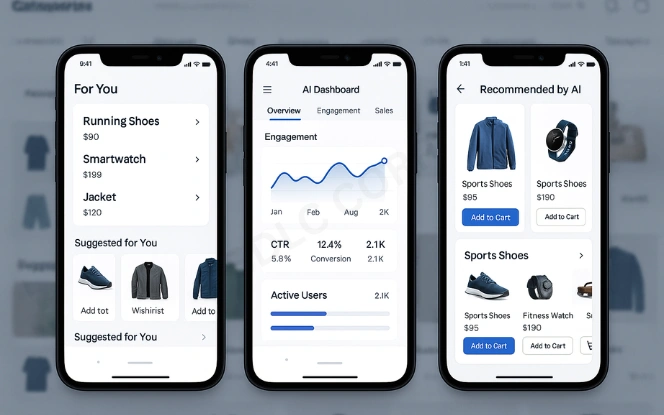
Personalization is central to modern shopping. Customers no longer want generic product suggestions; they expect relevance.
AI-powered product recommendations offer a smarter approach:
- Analyze browsing history, purchase records, and behavior in real time.
- Generate personalized product bundles instead of static suggestions.
- Adapt to changing customer intent within a single session.
Example:
A shopper browsing running shoes may also see:
- Performance socks for comfort.
- Smartwatches for fitness tracking.
- Weather-appropriate apparel for outdoor runs.
Business benefits:
- Higher conversion rates.
- Increased basket sizes.
- Long-term customer loyalty.
The key is transparency. Customers should feel these recommendations serve their interests, not just push promotions. Done well, personalization creates trust and repeat engagement.
Forecasting Demand with AI
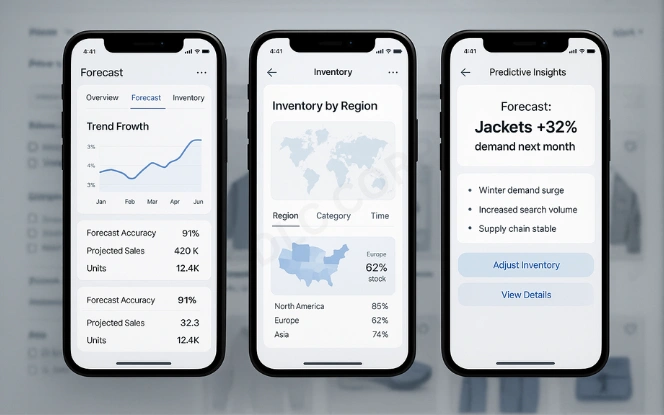
Demand forecasting is critical but often inaccurate when based only on past sales. Generative AI strengthens predictions by analyzing more variables.
Demand forecasting with generative AI uses:
- Historical sales data combined with promotions and seasonal cycles.
- External factors such as supply chain conditions or market trends.
- What-if scenarios to test the impact of campaigns or discounts.
Benefits:
- Reduced overstock and carrying costs.
- Fewer lost sales from stockouts.
- Better resource allocation across logistics and staffing.
Example:
A retailer launching a holiday collection can predict which styles will sell fastest, enabling smarter inventory distribution.
By moving from reactive to predictive planning, generative AI gives businesses agility. This makes forecasting not just a support function but a driver of competitive advantage. To understand connected approaches, read our insights on Generative AI for Supply Chain
Smarter Pricing Models
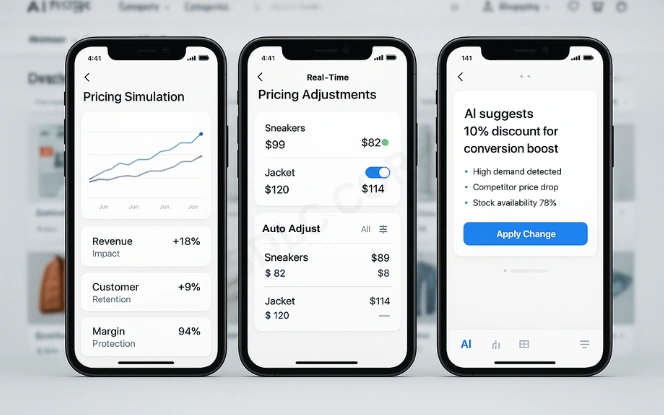
Pricing strategies affect both sales and customer trust. Static models cannot adjust to real-time market shifts.
Dynamic pricing in ecommerce using AI enables:
- Simulation of multiple scenarios for revenue optimization.
- Personalized discounts aligned with customer profiles.
- Real-time adjustments based on demand, competition, and stock levels.
Practical example:
- Prices may drop slightly on high-demand items to encourage quick conversions.
- Low-stock items may rise in price to protect margins.
Advantages:
- Improved profitability.
- Fairer, data-backed adjustments.
- Stronger perception of value among customers.
Balance required:
- AI handles data analysis and pricing suggestions.
- Human oversight ensures fairness and protects brand reputation.
When applied responsibly, dynamic pricing improves competitiveness while maintaining trust.
Search and Discovery

Search remains one of the most important elements of online retail. Poor search results push customers away.
AI-driven search personalization enhances discovery:
- Goes beyond keyword matching by understanding intent.
- Uses history, preferences, and behavior to rank results.
- Suggests complementary items naturally.
Example:
- A search for “hiking gear” may return boots, tents, and backpacks.
- A query for “winter jacket” adapts results based on gender, size, and location.
Benefits:
- Higher conversion rates.
- Longer session times.
- Reduced bounce rates.
Retailers must invest in clean, structured product data. Without it, even advanced AI cannot deliver accurate search results. Done well, search becomes a guided shopping journey rather than a static catalog lookup.
Challenges and Considerations
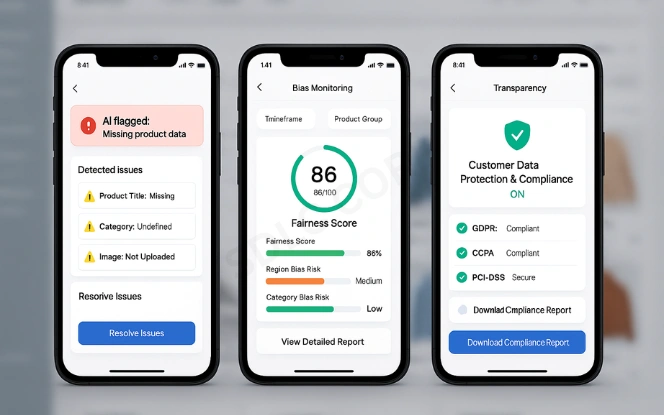
Adopting generative AI requires addressing risks.
Key challenges:
- Data quality: Poor inputs lead to poor results.
- Bias: Models may replicate unfair patterns.
- Transparency: Customers need clarity when AI shapes their journey.
- Costs: Building systems requires investment in tools and skills.
- Oversight: Humans must monitor outputs for compliance and ethics.
Best approach:
- Use AI for scale and speed.
- Maintain human checks for tone, fairness, and accuracy.
- Communicate openly with customers to build trust.
Generative AI brings clear benefits, but responsibility in its application ensures it strengthens customer relationships instead of weakening them.
Best Practices for Retailers
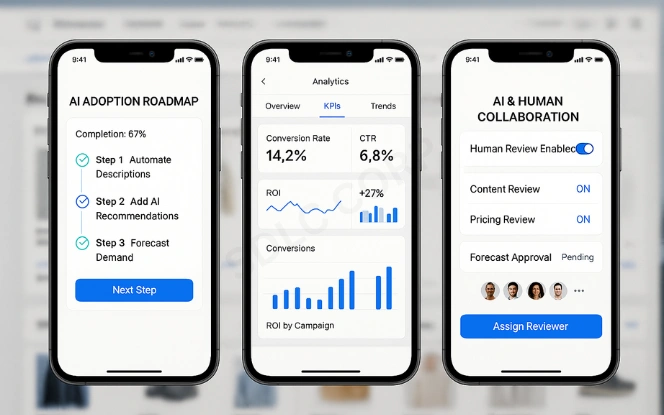
For successful adoption, retailers should follow structured steps:
- Start small: Test AI in one function like product descriptions.
- Measure outcomes: Track KPIs such as conversions and revenue.
- Blend human oversight: Use AI for scale, humans for nuance.
- Ensure data quality: Invest in accurate, up-to-date product information.
- Maintain compliance: Follow privacy laws and ethical standards.
- Update regularly: Train models with fresh data for accuracy.
Hybrid advantage:
By combining automation with oversight, businesses gain efficiency while protecting trust. This approach ensures that generative AI supports long-term success rather than creating short-lived gains.
Conclusion
Generative AI has moved from theory to practice. It is now transforming how e-commerce operates, from automated content creation to smarter pricing, personalized recommendations, forecasting, and search.
Retailers that apply it responsibly see clear results: faster catalog management, stronger customer loyalty, leaner operations, and improved profitability. Challenges remain bias, data quality, and transparency but these can be managed with oversight and strategy.
The opportunity is clear. Generative AI is not just about efficiency; it is about building better shopping experiences.
Contact us SDLC Corp to learn how your business can implement these solutions. If you are ready to move forward, Hire AI Development Services with SDLC Corp and bring the advantages of generative AI into your e-commerce journey.
FAQs
How Is Generative AI In Ecommerce Changing Online Retail?
Generative AI in ecommerce is transforming online retail by automating product descriptions, creating AI-powered product recommendations, and improving personalization. It helps retailers scale faster while delivering better customer experiences.
What Are The Benefits Of AI-Powered Product Recommendations?
AI-powered product recommendations improve shopping journeys by analyzing customer behavior, purchase history, and browsing patterns. They increase conversion rates, average basket size, and customer satisfaction
How Does Demand Forecasting With Generative AI Help Businesses?
Demand forecasting with generative AI helps businesses predict future sales more accurately by analyzing seasonal trends, promotions, and external factors. This leads to optimized inventory levels, reduced waste, and better customer service.
What Is Dynamic Pricing In Ecommerce Using AI?
Dynamic pricing in ecommerce using AI adjusts product prices in real time based on demand, stock levels, and competitor pricing. It allows businesses to stay competitive while protecting profit margins.
How Does AI-Driven Search Personalization Improve Customer Experience?
AI-driven search personalization improves customer experience by understanding intent instead of relying only on keywords. It delivers more relevant results, boosts product discovery, and increases overall satisfaction.











